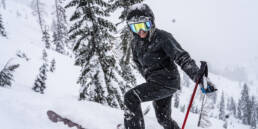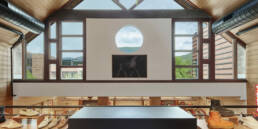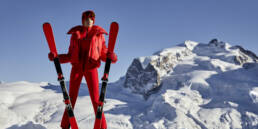The Descendants of Méribel reveal why the heart of Les Trois Vallées is “as English as Henley.”
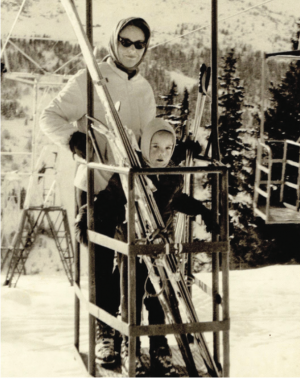
When I was about six, you’d tie me up, sprinkle with me with salt and pepper, and threaten to eat me,” says Emma Cooper-Key, one of the descendants of Méribel. “Did I really?” replies David Lindsay. “Yes,” Emma says. “You were ghastly.” The two friends, now each in their 50s, are reminiscing about their shared childhood in Méribel, the ski resort in France’s Savoie region described in Britain’s The Spectator as “an oasis of gentility… as English as Henley.”
They are drinking red wine in Emma’s four-story house in London’s Notting Hill. The home’s walls are covered with Emma’s own paintings, contemporary drawings, and Chris Levine’s iconic portraits of Her Majesty The Queen. Emma and David are sifting through old photographs of Méribel — photos that go back as far as the early sixties. Seeing a photograph of herself aged two, Emma leaves the room and returns with a tiny pair of faded blue wooden skis. “I remember skiing through grown ups’ legs on these,” she says.
This conversation is remarkable and more than just banter between old friends because without their two families, Méribel, home of La Folie Douce, may never have become what it is today: Cœur des Trois Vallées. Emma’s mother was one of the first privileged Brits to buy into the Savoie ski resort and, as for the Lindsays, without David’s father, Colonel Peter Lindsay, there might not have been a Méribel at all. Here’s how their familial stories go…
Advised by the great ski pioneer, Arnold Lunn, Peter Lindsay arrived in the valley of Les Allues in 1936. With two guides, including Celestin Gacon, who had served in the Chasseurs Alpins, Peter climbed Sommet de la Saulire on skins and skied seven miles down to Brides-les-Bains. “It’s said that my father fell in love with the valley that day,” David says. “It was he who named the place Méribel.” Translation: Beautiful to look at.
Soon after Peter Lindsay’s first descent into Brides-les-Bains, the intrepid Brit met Count Jean de Gaillard de la Valdène, a French WWI ace pilot. The first ski lift they built was the Red Dragon in 1938. “It was a giant sled with a tractor engine and 19 metal café chairs bolted onto it,” David says. “It was winched up by rope to the Télébar and driven by “Cigarette” Raffort, so named because he always had a fag hanging out of his mouth. It took half an hour to get up there.”
Then came WWII and Peter Lindsay, aged 39, enlisted in the Irish Guards, then joined the Special Operations Executive and went to Burma. “He returned to Méribel in 1946 as a Lieutenant Colonel with a Distinguished Service Order to take over from Jean for a bit. He intended to stay for nine months,” David says, “but stayed till he died there 25 years later.”
This is where Emma Cooper-Key’s relations come in. In 1938, two years after Peter Lindsay’s arrival, Lady Lorna Cooper-Key, Emma’s mother, ventured to Méribel. Lorna was a society beauty, the wife of Conservative MP Neill Cooper-Key, and the daughter of the second Viscount Rothermere, the family of Fleet Street proprietors who owned the Daily Mail.
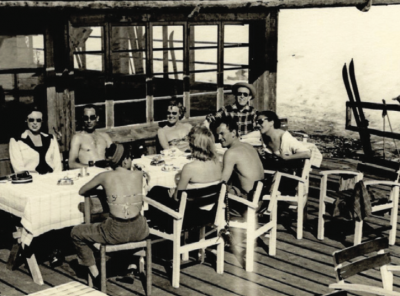
On her holiday in 1938, Lorna was accompanied by her friend, Barbara Dunn. “Mummy and Barbara went to Méribel to explore,” Emma says. “They went to the resort’s only bar and in walked Peter Lindsay with the architect Christian Durupt.” The chance meeting resulted in Barbara marrying Peter Lindsay in Paris in 1950. (Emma describes Barbara as so beautiful that later she was own out to Hollywood for screen tests.)
As for Lorna, that very night she began a relationship with Christian Durupt that continued till his death in 1996. “Christian gave Mummy a gold watch and she had to pretend she’d lost the one Daddy had given her and spent the insurance money on a new one,” Emma says. “We all knew about the a air. Daddy was at home in Sussex (Sir Neill was Member of Parliament for Hastings between 1945 and 1970) and working in the city; we were used to being alone with Mummy.”
By the time Lorna and Barbara had begun their a airs, Peter Lindsay had already begun his lifelong work of creating Méribel. With Christian Durupt and fellow architects, Paul Grillo, Dédé Detour, and Georges Buzzi, they developed its distinctive Savoyard style. “Between Peter and Christian it was decided that all buildings had to have pitched roofs, wood or stone walls, and look very Swiss with little balconies,” Emma says. “There were to be no at roofs or concrete.”
“The process of chalet building followed a set formula,” David explains. “Visitors would be put up by Marie Blanche in her guesthouse in Musillon, and later in her charming hotel, Chalet Hotel Marie Blanche. If, in time, they developed an interest in building, my father might sell them a piece of land and Christian would design their chalet.”
“Mummy hated the idea of a little chalet with freezing pipes,” Emma says. “She’d bought some land up the mountain and she gave it to a developer to build an apartment block in exchange for two big flats in the block. Christian was obviously the architect so everything looked fabulous and there were great big bathrooms before people had big bathrooms. You could open the two flats into one so we ended up with the biggest at in Méribel. Before that we always stayed with Marie Blanche; I even remember my 9th birthday party there.”
Another person who remembers Marie Blanche fondly is Julian Tomkins, whose parents, Sir Edward and Lady Tomkins, were among the privileged Brits to help lift the Méribel development to its current status. Like Emma and David, Julian loves to reminisce about his Méribel childhood, as he does one evening with Emma over a quiet dinner in Notting Hill. “Marie Blanche had the only hotel and was like my surrogate mum,” he says. “I remember sitting on her big terrace looking straight down the valley when there were literally no more than a dozen ski lifts in the whole place. Our chalet was built in 1960 and we went there for Christmas, Easter, and summer, so Méribel was an absolute constant in my childhood.”
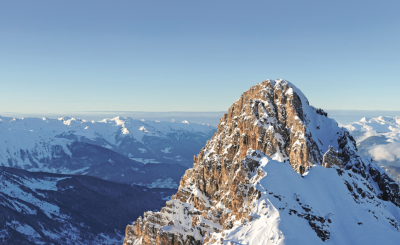 Julian’s father was a press counsellor at the British Embassy in Paris (later, during the 1970s, he returned as ambassador) and Peter Lindsay’s friend. “In the mid-1950s Peter said to him, ‘I have a dream for this place and we need to get some publicity,’” says Julian. “So Dad organised a handful of British journalists to go out there. They arrived in mid-December and wound their way up the tortuous mountain road to Marie Blanche’s hotel. It was raining and they all looked fairly glum but they had a good skinful and went to bed. When they woke it was snowing. When it eventually stopped, off they went, up in two tiny lifts to ski down an entirely virgin mountain. They all fell in love with the place.”
Julian’s father was a press counsellor at the British Embassy in Paris (later, during the 1970s, he returned as ambassador) and Peter Lindsay’s friend. “In the mid-1950s Peter said to him, ‘I have a dream for this place and we need to get some publicity,’” says Julian. “So Dad organised a handful of British journalists to go out there. They arrived in mid-December and wound their way up the tortuous mountain road to Marie Blanche’s hotel. It was raining and they all looked fairly glum but they had a good skinful and went to bed. When they woke it was snowing. When it eventually stopped, off they went, up in two tiny lifts to ski down an entirely virgin mountain. They all fell in love with the place.”
“Brian Connell was a political correspondent and very in uential,” Julian continues. “He was a friend of my parents, larger than life, good fun, avuncular with a loud, booming voice, and spoke very good French. He really helped put Méribel on the map and other influential people soon starting coming on board.”
By the 1960s, Méribel had established itself as a chic, exclusive, privately owned resort. Brigitte Bardot arrived in a Rolls-Royce with her third husband, Gunter Sachs, and French actor Sami Frey. Betty Kenward, once described as the “doyenne of professional partygoers,” wrote of her visit in the society pages. Plus, Méribel was popularized as a playground for aristocratic, well-heeled Brits. Julian remembers the Duke of Bedford being there with his new wife, Nicole, a French divorcée and television producer: “Though she later turned Woburn Abbey into a very viable business, she never really wanted to be chatelaine,” Julian explains, “so they spent a lot of time in Méribel, in the same block of ats as Lorna Copper-Key’s. In the 1970s, she wrote in her memoir Nicole Nobody about a stranger breaking into her hotel room in Manchester, staying for three days, and proving to be ‘a superb lover.’ It caused a right old scandal in Méribel.” “It was such fun and we were quite a gang,” Emma Cooper-Key chimes in. “Julian and his sisters and the Lindsays. As we grew up, I remember Emma and Harriet Sargent having lipstick that matched their ski suits and going heli-skiing with their father, Patrick, who started Euromoney. We weren’t used to that level of sophistication!”
Despite Méribel’s growing reputation for being exclusive, Emma, David, and Julian all remember that the majority of their childhood friends were locals, that luxury was by no means a given, and that skiing was not always pleasurable.
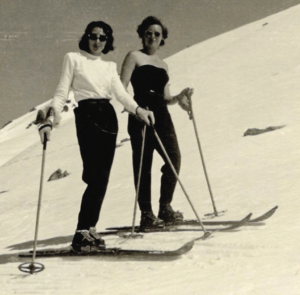
“We were only allowed to take £50 in cash out of England back then, so you had to fill up the car with everything you needed, including food,” Emma says. “And when we got there we were pretty frugal. Sometimes we’d eat at the top of the mountain, but if we ordered steaks, my parents would view us as aliens, so we ordered the cheapest things, like œufs au jambon.”
“We skied and we skied and we skied,” adds Julian. “The instructors were the local village tradesmen. They were terribly kind and we all became buddies as their kids were in ski school too. There was no separation between them and us Brits. My best mates were the local boys and when we went back in the summer we
all met again in a non-skiing context.”
“In the summer, Frederic Saint Guillhem, who now has Hôtel Le Yéti in Méribel, used to take over empty barns for nightclubs,” Emma remembers. “Of course, we all piled in. It was there that Stéphane Catella, the son of a ski instructor, gave me my first kiss; I didn’t get home till 6 a.m. Mummy went ballistic… but I wasn’t the only one behaving badly. My older brother Esmond came to Méribel with Richard Northcote, Nigel Pulitzer, Jamie Robertson, and Paddy McNally — Britain’s ‘70s jet set. If Jamie Robertson heard that a couple of debutantes had arrived to be chalet girls, he’d sit on the sofa stark naked except for his ski boots. The boys would steal the girls’ cameras and take photographs of themselves mooning; their mothers would discover the photographs only after the films were developed — those were the days when you bought a film and took about 24 shots the entire holiday!”
Zoom forward to present day and all three descendants of Méribel’s early movers and shakers are nostalgic for the old days.
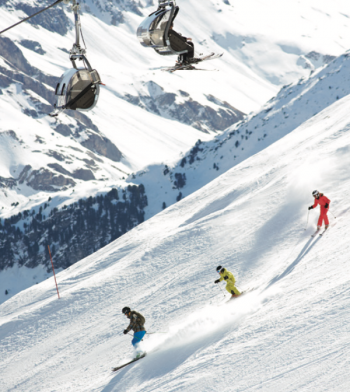 Julian Tomkins, his sister and her family still have a home in Méribel, though Julian only occasionally visits now that he finds the place so changed. His parents’ chalet was demolished to make way for his sister’s new abode, one Julian refers to as Palais Tomkins. “When the original Chalet Tomkins was built, ours was the highest in the resort apart from the Lindsays’ above us and the Méribel Hotel. Now Méribel is massively bigger and our chalet is lost in a morass of houses,” he says. He sighs sadly.
Julian Tomkins, his sister and her family still have a home in Méribel, though Julian only occasionally visits now that he finds the place so changed. His parents’ chalet was demolished to make way for his sister’s new abode, one Julian refers to as Palais Tomkins. “When the original Chalet Tomkins was built, ours was the highest in the resort apart from the Lindsays’ above us and the Méribel Hotel. Now Méribel is massively bigger and our chalet is lost in a morass of houses,” he says. He sighs sadly.
As for David Lindsay, his father Peter, the founder of Méribel, died in 1971; his ashes are scattered on the Dent de Burgin. David, now a ski pro, spends at least part of each winter on his father’s beloved slopes teaching students how to ski o -piste. In one sense, it’s a tribute to the enterprising colonel, who first skinned and skied the valley of Les Allues in 1936. He clearly nds solace and pride in being able to continue his father’s adventurous legacy.
And finally, there’s the last descendant, Emma Cooper-Key. Back in her Notting Hill home, a pretty little green-eyed Bengal cat slinks in from the garden and jumps onto Emma’s lap. The granddaughter of the second Viscount Rothermere explains regretfully that she sold her mother’s at in Méribel — the one
with the gracious proportions and enormous restrooms. Nowadays, Emma spends her winters on a beach in India or in Cornwall, where she has built a stunning slate and glass house on a quarry overlooking the Camel Estuary. There is a tangible air of melancholy as she takes one last look at an old photograph of herself skiing with her mother Lorna in Méribel. “I felt so connected to it,” she says. “There is not a day that I don’t miss it.” With that she puts the photograph back into a brown envelope, clears the wineglasses, and slides back into the present.
meribel.net
Charlotte Metcalf


